German reunification
| Part of the Die Wende | |
| Date | 9 November 1989 – 15 March 1991 |
|---|---|
| Location | |
| Cause | Revolutions of 1989 |
| Outcome | Reunification of Germany under the Federal Republic
|
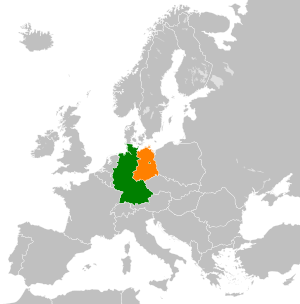

German reunification (German: Deutsche Wiedervereinigung) was the process of re-establishing Germany as a single full sovereign state, which took place between 9 November 1989 and 15 March 1991. The "Unification Treaty" entered into force on 3 October 1990, dissolving the German Democratic Republic (GDR; German: Deutsche Demokratische Republik, DDR, or East Germany) and integrating its recently re-established constituent federated states into the Federal Republic of Germany (FRG; German: Bundesrepublik Deutschland, BRD, or West Germany) to form present-day Germany. This date has been chosen as the customary German Unity Day (Tag der deutschen Einheit), and has thereafter been celebrated each year as a national holiday in Germany since 1991.[1] As part of the reunification, East and West Berlin of the two countries were also de facto united into a single city, which eventually became the capital of this country.
The
After the
The reunited state is not a
Naming
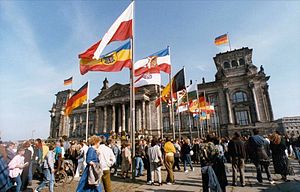
The term "German reunification" was given to the process of the German Democratic Republic joining the Federal Republic of Germany with full German sovereignty from the
After 1990, the term die Wende became more common. The term generally refers to the events (mostly in Eastern Europe) that led up to the actual reunification, and loosely translates to "the turning point". Anti-communist activists from Eastern Germany rejected the term Wende as it had been introduced by the SED Secretary General Egon Krenz.[4]
Some people have stated that the reunification can be classified as an annexation of the GDR by the FRG.[5][6][7][8][9][10][11] Scholar Ned Richardson-Little from the University of Erfurt noted that the terminology of an annexation can be interpreted from backgrounds across the political spectrum.[12] In 2015, a Russian proposal was made that classified it as an annexation. Mikhail Gorbachev named it 'nonsense'.[13][14] In 2010, Matthias Platzeck referred to the reunification as an 'anschluss'.[15]
Precursors to reunification
| History of Germany |
|---|
 |

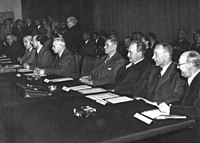


On 5 June 1945, with the Berlin Declaration, the defeat of
Among the Allies, geo-political tension between the Soviet Union and Western Allies in
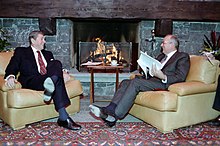
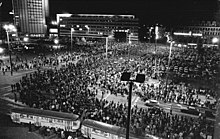
Tens of thousands of the media-informed East Germans now made their way to Hungary, which was no longer ready to keep its borders completely closed or to oblige its border troops to use force of arms. By the end of September 1989, more than 30,000 East German citizens had escaped to the West before the GDR denied travel to Hungary, leaving Czechoslovakia as the only neighboring state to which East Germans could escape.[31][32]
Even then, many people within and outside Germany still believed that real reunification between the two countries would never happen in the foreseeable future.
Process of reunification
Cooperation

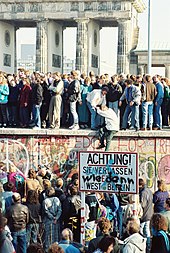
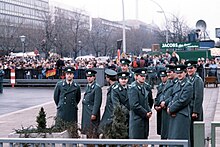
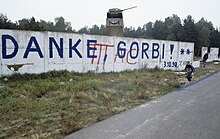
On 28 November 1989—two weeks after the fall of the Berlin Wall—West German Chancellor Helmut Kohl announced a 10-point program calling for the two Germanies to expand their cooperation with a view toward eventual reunification.[34]
Initially, no timetable was proposed. However, events rapidly came to a head in early 1990. First, in March, the
Economic merger
Discussions immediately began on an emergency merger of the German economies. On 18 May 1990, the two German states signed a treaty agreeing on monetary, economic, and social union. This treaty is called Vertrag über die Schaffung einer Währungs-, Wirtschafts- und Sozialunion zwischen der Deutschen Demokratischen Republik und der Bundesrepublik Deutschland ("Treaty Establishing a Monetary, Economic and Social Union between the German Democratic Republic and the Federal Republic of Germany");[35] it came into force on 1 July 1990, with the West German Deutsche Mark replacing the East German mark as the official currency of East Germany. The Deutsche Mark had a very high reputation among the East Germans and was considered stable.[36] While the GDR transferred its financial policy sovereignty to West Germany, the West started granting subsidies for the GDR budget and social security system.[37] At the same time, many West German laws came into force in the GDR. This created a suitable framework for a political union by diminishing the huge gap between the two existing political, social, and economic systems.[37]
German Reunification Treaty

The Volkskammer, the Parliament of East Germany, passed a resolution on 23 August 1990 declaring the accession (Beitritt) of the German Democratic Republic to the Federal Republic of Germany, and the extension of the field of application of the Federal Republic's Basic Law to the territory of East Germany as allowed by Article 23 of the West German Basic Law, effective 3 October 1990.[38][39][40] This Declaration of Accession (Beitrittserklärung) was formally presented by the President of the Volkskammer, Sabine Bergmann-Pohl, to the President of the West German Bundestag, Rita Süssmuth, by means of a letter dated 25 August 1990.[40] Thus, formally, the procedure of reunification by means of the accession of East Germany to West Germany, and of East Germany's acceptance of the Basic Law already in force in West Germany, was initiated as the unilateral, sovereign decision of East Germany, as allowed by the provisions of article 23 of the West German Basic Law as it then existed.
In the wake of that resolution of accession, the "German reunification treaty",[41][42][43] commonly known in German as "Einigungsvertrag" (Unification Treaty) or "Wiedervereinigungsvertrag" (Reunification Treaty), that had been negotiated between the two German states since 2 July 1990, was signed by representatives of the two governments on 31 August 1990. This Treaty, officially titled Vertrag zwischen der Bundesrepublik Deutschland und der Deutschen Demokratischen Republik über die Herstellung der Einheit Deutschlands (Treaty between the Federal Republic of Germany and the German Democratic Republic on the Establishment of German Unity), was approved by large majorities in the legislative chambers of both countries on 20 September 1990 (442–47 in the West German Bundestag and 299–80 in the East German Volkskammer).[44] The Treaty passed the West German Bundesrat on the following day, 21 September 1990. The amendments to the Federal Republic's Basic Law that were foreseen in the Unification Treaty or necessary for its implementation were adopted by the Federal Statute of 23 September 1990, that enacted the incorporation of the Treaty as part of the Law of the Federal Republic of Germany. The said Federal Statute, containing the whole text of the Treaty and its Protocols as an annex, was published in the Bundesgesetzblatt (the official journal for the publication of the laws of the Federal Republic) on 28 September 1990.[45] In the German Democratic Republic, the constitutional law (Verfassungsgesetz) giving effect to the Treaty was also published on 28 September 1990.[40] With the adoption of the Treaty as part of its Constitution, East Germany legislated its own abolition as a separate state.
Under article 45 of the Treaty,
Constitutional merger

The process chosen was one of the two options set out in the
The other option was set out in Article 146, which provided a mechanism for a permanent constitution for a reunified Germany. This route would have entailed a formal union between two German states that then would have had, among other things, to create a new constitution for the newly-established country. However, by the spring of 1990, it was apparent that drafting a new constitution would require protracted negotiations that would open up numerous issues in West Germany. Even without this to consider, by the start of 1990 East Germany was in a state of economic and political collapse. In contrast, reunification under Article 23 could be implemented in as little as six months. Ultimately, when the treaty on monetary, economic, and social union was signed, it was decided to use the quicker process of Article 23. By this process, East Germany voted to dissolve itself and to join West Germany, and the area in which the Basic Law was in force was simply extended to include its constituent parts.[47] Thus, while legally East Germany as a whole acceded to the Federal Republic, the constituent parts of East Germany entered into the Federal Republic as five new states, which held their first elections on 14 October 1990.
Nevertheless, although the Volkskammer's declaration of accession to the Federal Republic had initiated the process of reunification, the act of reunification itself (with its many specific terms, conditions, and qualifications, some of which required amendments to the Basic Law itself) was achieved constitutionally by the subsequent Unification Treaty of 31 August 1990; that is, through a binding agreement between the former GDR and the Federal Republic now recognizing each another as separate sovereign states in international law.[48] This treaty was then voted into effect by both the Volkskammer and the Bundestag by the constitutionally required two-thirds majorities, effecting on the one hand, the extinction of the GDR, and on the other, the agreed amendments to the Basic Law of the Federal Republic. Hence, although the GDR declared its accession to the Federal Republic under Article 23 of the Basic Law, this did not imply its acceptance of the Basic Law as it then stood, but rather of the Basic Law as subsequently amended in line with the Unification Treaty.
Legally, the reunification did not create a third state out of the two. Rather, West Germany effectively absorbed East Germany. Accordingly, on Unification Day, 3 October 1990, the German Democratic Republic ceased to exist, and five new federated states on its former territory joined the Federal Republic of Germany. East and West Berlin were reunited as the third full-fledged federated city-state of the enlarged Federal Republic. The reunited city became the capital of the enlarged Federal Republic. Under this model, the Federal Republic of Germany, now enlarged to include the five states of the former GDR plus the reunified Berlin, continued to exist under the same legal personality that was founded in May 1949.
While the Basic Law was modified, rather than replaced by a constitution as such, it still permits the adoption of a formal constitution by the German people at some time in the future.
Unification of Berlin
In the context of urban planning, in addition to a wealth of new opportunity and the symbolism of two former independent states being rejoined, the reunification of Berlin presented numerous challenges. The city underwent massive redevelopment, involving the political, economic, and cultural environment of both East and West Berlin. However, the "scar" left by the Wall, which ran directly through the very heart of the city,[49] had consequences for the urban environment that planning still needs to address.
The unification of Berlin presented legal, political, and technical challenges for the urban environment. The political division and physical separation of the city for more than 30 years saw the East and the West develop their own distinct urban forms, with many of these differences still visible to this day.[50] As urban planning in Germany is the responsibility of the city government,[51] the integration of East and West Berlin was in part complicated by the fact that the existing planning frameworks became obsolete with the fall of the Wall.[52] Prior to the reunification of the city, the Land Use Plan of 1988 and General Development Plan of 1980 defined the spatial planning criteria for West and East Berlin, respectively.[52] These were replaced by the new, unified Land Use Plan in 1994.[52] Termed "Critical Reconstruction", the new policy aimed to revive Berlin's prewar aesthetic;[53] it was complemented by a strategic planning document for downtown Berlin, entitled "Inner City Planning Framework".[53]
Following the dissolution of the GDR on 3 October 1990, all planning projects under the socialist-totalitarian regime were abandoned.[54] Vacant lots, open areas, and empty fields in East Berlin were subject to redevelopment, in addition to space previously occupied by the Wall and associated buffer zone.[51] Many of these sites were positioned in central, strategic locations of the reunified city.[52]
Day of German Unity
To commemorate the day that marks the official unification of the former East and West Germany in 1990, 3 October has since then been the official national holiday of Germany, the
Domestic opposition
Throughout the entire Cold War and until 1990, reunification did not appear likely, and the existence of two German countries was commonly regarded as an established, unalterable fact.
Opinion polls in the late 1980s showed that young East Germans and West Germans saw each other as foreign, and did not regard themselves as a single nation.[57] Heinrich August Winkler observes that "an evaluation of the corresponding data in the Deutschland Archiv in 1989 showed that the GDR was perceived by a large portion of the younger generation as a foreign nation with a different social order which was no longer a part of Germany".[57] Winkler argues that the reunification was not a product of popular opinion, but rather "crisis management on the highest level".[57] Support for unified Germany fell once the prospect of it became a tangible reality in the fall of 1989.[58] A December 1989 poll by Der Spiegel indicated strong support for preserving East Germany as a separate state.[60] However, SED members were overrepresented amongst the responders, constituting 13% of the population, but 23% of those polled. Reporting on a student protest in East Berlin on 4 November 1989, Elizabeth Pond noted that "virtually none of the demonstrators interviewed by Western reporters said they wanted unification with the Federal Republic".[60] In West Germany, once it became clear that a course of quick unification was negotiated, the public responded with concern.[58] In February 1990, two-thirds of West Germans considered the pace of unification as "too fast". West Germans were also hostile towards the newcomers from the East—according to an April 1990 poll, only 11% of West Germans welcomed the refugees from East Germany.[61]
After unification, the national divide persisted—a survey by the Allensbach Institute in April 1993 found that only 22% of West Germans and 11% of East Germans felt they were one nation.[57] Dolores L. Augustine observed that "the sense of oneness felt by East Germans and West Germans in the euphoric period after the fall of the wall proved all too transitory", as the old divisions persisted and Germans not only still saw themselves as two separate people, but also acted in accordance with their separate, regional interests.[62] This state of mind became known as Mauer im Kopf ("wall in the head"), suggesting that despite the fall of the Berlin Wall, a "psychological wall" still existed between East and West Germans. Augustine argues that despite resistance to the political regime of East Germany, it still represented the history and identity of East Germans. Unification caused backlash, and the Treuhandanstalt, an agency created to carry out privatization, was blamed for creating mass unemployment and poverty in the East.[62]
Social groups and figures
An influential part of the reunification opponents were the so-called
According to
There was also a significant opposition to the unification in intellectual circles. Christa Wolf and Manfred Stolpe stressed the need to forge an East German identity, while "citizens' initiatives, church groups, and intellectuals of the first hour began issuing dire warnings about a possible Anschluss of the GDR by the Federal Republic".[59][62] Many East German oppositionists and reformers advocated for a "third path" of an independent, democratic socialist East Germany.[59] Stefan Heym argued that the preservation of the GDR was necessary to achieve the ideal of democratic socialism, urging East Germans to oppose "capitalist annexation" in favour of a democratic socialist society.[59] Writers in both East and West were concerned about the destruction of the East German or West German cultural identity respectively; in "Goodbye to the Literature of the Federal Republic", Frank Schirrmacher states that the literature of both states had been central to the consciousness and unique identity of both nations, with this newly developed culture being now endangered by looming reunification.[59]
Foreign support and opposition
For decades, West Germany's allies stated their support for reunification.
A poll of four countries in January 1990 found that a majority of surveyed Americans and French supported reunification, while British and Poles were more divided: 69 percent of Poles and 50 percent of French and British stated that they worried about a reunified Germany becoming "the dominant power in Europe". Those surveyed stated several concerns, including Germany again attempting to expand its territory, a revival of Nazism, and the
The key ally was the United States. Although some top American officials opposed quick unification, Secretary of State
United Kingdom and France
We defeated the Germans twice! And now they're back!
— Margaret Thatcher, December 1989[72]
Thatcher, who carried in her handbag a map of
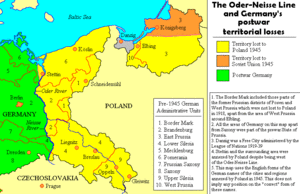
The pace of events surprised the French, whose Foreign Ministry had concluded in October 1989 that reunification "does not appear realistic at this moment".
Rest of Europe
I love Germany so much that I prefer to see two of them.
— Giulio Andreotti, Prime Minister of Italy, quoting François Mauriac[78]
Ireland's Taoiseach, Charles Haughey, supported German reunification and he took advantage of Ireland's presidency of the European Economic Community to call for an extraordinary European summit in Dublin in April 1990 to calm the fears held of fellow members of the EEC.[79][80][81] Haughey saw similarities between Ireland and Germany, and said "I have expressed a personal view that coming as we do from a country which is also divided many of us would have sympathy with any wish of the people of the two German States for unification".[82] Der Spiegel later described other European leaders' opinion of reunification at the time as "icy". Italy's Giulio Andreotti warned against a revival of "pan-Germanism" and the Netherlands's Ruud Lubbers questioned the German right to self-determination. They shared Britain's and France's concerns over a return to German militarism and the economic power of a reunified country. The consensus opinion was that reunification, if it must occur, should not occur until at least 1995 and preferably much later.[66] Andreotti, quoting François Mauriac, joked "I love Germany so much that I prefer to see two of them".[78]
Final settlement
The victors of World War II—France, the Soviet Union, the United Kingdom, and the United States, comprising the Four-Power Authorities—retained authority over Berlin, such as control over air travel and its political status. From the onset, the Soviet Union sought to use reunification as a way to push Germany out of NATO into neutrality, removing nuclear weapons from its territory. However, West Germany misinterpreted a 21 November 1989 diplomatic message on the topic to mean that the Soviet leadership already anticipated reunification only two weeks after the Wall's collapse. This belief, and the worry that his rival Genscher might act first, encouraged Kohl on 28 November to announce a detailed "Ten Point Program for Overcoming the Division of Germany and Europe". While his speech was very popular within West Germany, it caused concern among other European governments, with whom he had not discussed the plan.[66][83]
The Americans did not share the Europeans' and Soviets' historical fears over German expansionism; Condoleezza Rice later recalled,[84]
The United States—and President George H. W. Bush—recognized that Germany went through a long democratic transition. It was a good friend, it was a member of NATO. Any issues that existed in 1945, it seemed perfectly reasonable to lay them to rest. For us, the question wasn't should Germany unify? It was how and under what circumstances? We had no concern about a resurgent Germany...
The United States wished to ensure, however, that Germany would stay within NATO. In December 1989, the administration of President George H. W. Bush made a united Germany's continued NATO membership a requirement for supporting reunification. Kohl agreed, although less than 20 percent of West Germans supported remaining within NATO. Kohl also wished to avoid a neutral Germany, as he believed that would destroy NATO, cause the United States and Canada to leave Europe, and cause Britain and France to form an anti-German alliance. The United States increased its support of Kohl's policies, as it feared that otherwise Oskar Lafontaine, a critic of NATO, might become Chancellor.[66] Horst Teltschik, Kohl's foreign policy advisor, later recalled that Germany would have paid "100 billion deutschmarks" if the Soviets demanded it. The USSR did not make such great demands, however, with Gorbachev stating in February 1990 that "[t]he Germans must decide for themselves what path they choose to follow". In May 1990, he repeated his remark in the context of NATO membership while meeting Bush, amazing both the Americans and Germans.[66] This removed the last significant roadblock to Germany being free to choose its international alignments, though Kohl made no secret that he intended for the reunified Germany to inherit West Germany's seats in NATO and the EC.
During a NATO–Warsaw Pact conference in
German sovereignty and withdrawal of the Allied Forces
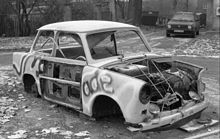

On 15 March 1991, the Treaty on the Final Settlement with Respect to Germany—that had been signed in Moscow back on 12 September 1990 by the two German states that then existed (East and West Germany) on one side and by the four principal Allied powers (the United Kingdom, France, the Soviet Union, and the United States) on the other—entered into force, having been ratified by the Federal Republic of Germany (after the unification, as the united Germany) and by the four Allied states. The entry into force of that treaty (also known as the "Two Plus Four Treaty", in reference to the two German states and four Allied governments that signed it) put an end to the then-remaining limitations on German sovereignty and the ACC that resulted from the post-World War II arrangements. After the Americans intervened,[66] both the United Kingdom and France ratified the Treaty on the Final Settlement with Respect to Germany in September 1990. The Treaty entered into force on 15 March 1991, in accordance with Article 9 of the Two Plus Four Treaty, it entered into force as soon as all ratifications were deposited with the Government of Germany, thus finalizing the reunification for purposes of international law. The last party to ratify the treaty was the Soviet Union, that deposited its instrument of ratification on 15 March 1991. The Supreme Soviet of the USSR only gave its approval to the ratification of the treaty on 4 March 1991, after a hefty debate. Even prior to the ratification of the Treaty, the operation of all quadripartite Allied institutions in Germany was suspended, with effect from the reunification of Germany on 3 October 1990 and pending the final ratification of the Two Plus Four Treaty, pursuant to a declaration signed in New York on 1 October 1990 by the foreign ministers of the four Allied Powers, that was witnessed by ministers of the two German states then in existence, and that was appended text of the Two Plus Four Treaty.[85] However, the Soviets cited their occupation rights for the last time as late as on 13 March 1991, just two days before the Treaty became effective, when the Honeckers were enabled by Soviet hardliners to flee Germany on a military jet to Moscow from the Soviet-controlled Sperenberg Airfield, with the German Federal Government being notified of this in advance of just one hour.[86]
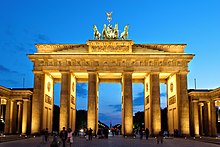
Under the treaty on final settlement (which should not be confused with the Unification Treaty that was signed only between the two German states), the last Allied forces still present in Germany left in 1994, in accordance with article 4 of the treaty, that set 31 December 1994 as the deadline for the withdrawal of the remaining Allied forces. The bulk of
Article 5 banned the deployment of nuclear weapons in the territory previously controlled by the GDR and well as a ban on stationing non-German military personnel.[89]
Polish border
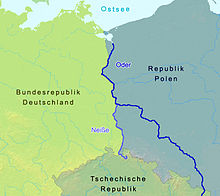
On 14 November 1990,
As for the German–Polish Border Treaty, it was approved by the Polish Sejm on 26 November 1991 and the German Bundestag on 16 December 1991, and entered into force with the exchange of the instruments of ratification on 16 January 1992. The confirmation of the border between Germany and Poland was required of Germany by the four Allied countries in the Two Plus Four Treaty. The Treaty was later supplemented by the Treaty of Good Neighbourship between the two countries which took effect on 16 January 1992 and also made the few remaining Germans in Poland (mostly in Upper Silesia) be treated better by the host government.
Effects
International effects
The reunification made Germany into a
To facilitate this process and to reassure other countries, fundamental changes were made to the German constitution. The Preamble and Article 146 were amended, and Article 23 was replaced, but the deleted former Article 23 was applied as the constitutional model to be used for the 1990 reunification. Hence, prior to the five "New Länder" of East Germany joining, the Basic Law was amended to indicate that all parts of Germany would then be unified such that Germany could now no longer consider itself constitutionally open to further extension to include the
Domestic effects
Vast differences between former East Germany and West Germany in lifestyle, wealth, political beliefs, and other matters remain, and it is therefore still common to speak of eastern and western Germany distinctly. It is often referred to as the "wall in the head" (Mauer im Kopf).
The economy of eastern Germany has struggled since unification, and large subsidies are still transferred from west to east. Economically, eastern Germany has had a sharp rise of 10 percent to West Germany's 5 percent. Western Germany also still holds 56 percent of the GDP. Part of this disparity between the East and the West lies in the Western labor unions' demand for high-wage pacts in an attempt to prevent "low-wage zones". This caused many Germans from the East to be outpriced in the market, adding to the slump in businesses in eastern Germany as well as the rising unemployment.

Politicians and scholars have frequently called for a process of "inner reunification" of the two countries and asked whether there is "inner unification or continued separation".[96] "The process of German unity has not ended yet", proclaimed Chancellor Angela Merkel, who grew up in East Germany, in 2009.[97] Nevertheless, the question of this "inner reunification" has been widely discussed in the German public, politically, economically, culturally, and also constitutionally since 1989.
Politically, since the fall of the Berlin Wall, the successor party of the former East German socialist state party has become a major force in German politics. It was renamed PDS, and, later, merged with the Western leftist party WASG to form the Left Party (Die Linke).
Constitutionally, the Basic Law of West Germany (
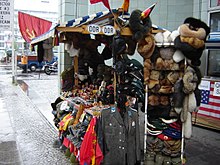
The economic reconstruction of former East Germany following the reunification required large amounts of public funding which turned some areas into boom regions, although overall unemployment remains higher than in the former West.[102] Unemployment was part of a process of deindustrialization starting rapidly after 1990. Causes for this process are disputed in political conflicts up to the present day. Most times bureaucracy and lack of efficiency of the East German economy are highlighted and the deindustrialization is seen as an inevitable outcome of the Wende. But many critics from East Germany point out that it was the shock-therapy style of privatization that did not leave room for East German enterprises to adapt, and that alternatives like a slow transition had been possible.[g]
Reunification did, however, lead to a large rise in the average standard of living in former East Germany, and a stagnation in the West as $2 trillion in public spending was transferred East.[105] Between 1990 and 1995, gross wages in the east rose from 35 percent to 74 percent of western levels, while pensions rose from 40 percent to 79 percent.[106] Unemployment reached double the western level as well. West German cities close to the former border of East and West Germany experienced a disproportionate loss of market access[clarification needed] relative to other West German cities which were not as greatly affected by the reunification of Germany.[107]
Unified Berlin
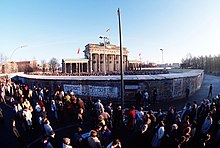
While the fall of the Berlin Wall had broad economic, political, and social impacts globally, it also had significant consequence for the local urban environment. In fact, the events of 9 November 1989 saw East Berlin and West Berlin, two halves of a single city that had ignored one another for the better part of 40 years, finally "in confrontation with one another".[108] There was a belief in the city that, after 40 years of division, the unified city would be well placed to become a major metropolis.[109][53]

Another key priority was reestablishing Berlin as the seat of government of Germany, and this required buildings to serve government needs, including the "redevelopment of sites for scores of foreign embassies".[51]
With respect to redefining the city's identity, emphasis was placed on restoring Berlin's traditional landscape. "Critical Reconstruction" policies sought to disassociate the city's identity from its
Immediately following the fall of the Wall, Berlin experienced a boom in the construction industry.[50] Redevelopment initiatives saw Berlin turn into one of the largest construction sites in the world through the 1990s and early 2000s.[52]
The fall of the Wall also had economic consequences. Two German systems covering distinctly divergent degrees of economic opportunity suddenly came into intimate contact.[110] Despite development of sites for commercial purposes, Berlin struggled to compete in economic terms with Frankfurt which remained the financial capital of the country, as well as with other key West German centers such as Munich, Hamburg, Stuttgart and Düsseldorf.[111][112] The intensive building activity directed by planning policy resulted in the over-expansion of office space, "with a high level of vacancies in spite of the move of most administrations and government agencies from Bonn".[50][113]
Berlin was marred by disjointed economic restructuring, associated with massive deindustrialisation.[111][112] Economist Oliver Marc Hartwich asserts that, while the East undoubtedly improved economically, it was "at a much slower pace than [then Chancellor Helmut] Kohl had predicted".[114] Wealth and income inequality between former East and West Germany continued for decades after reunification. On average, adults in the former West Germany had assets worth 94,000 euros in 2014 as compared to the adults in the former communist East Germany which had just over 40,000 euros in assets.[115] The fall of the Berlin Wall and the factors described above led to mass migration from East Berlin and East Germany, producing a large labor supply shock in the West.[110] Emigration from the East, totaling 870,000 people between 1989 and 1992 alone,[116] led to worse employment outcomes for the least-educated workers, for blue-collar workers, for men, and for foreign nationals.[110]
At the close of the century, it became evident that despite significant investment and planning, Berlin was unlikely to retake "its seat between the European Global Cities of
Yet, ultimately, the disparity between East and West portions of Berlin has led to the city achieving a new urban identity. A number of locales of East Berlin, characterized by dwellings of in-between use of abandoned space for little to no rent, have become the focal point and foundation of Berlin's burgeoning creative activities.[117] According to Berlin Mayor Klaus Wowereit, "the best that Berlin has to offer, its unique creativity. Creativity is Berlin's future."[117] Overall, the Berlin government's engagement in creativity is strongly centered on marketing and promotional initiatives instead of creative production.[118]
Assessment
Cost of reunification
The subsequent economic restructuring and reconstruction of
Views and life satisfaction
According to a 2019 survey conducted by Pew Research Center, 89 percent of Germans living in both the West and East believe that reunification was good for Germany, with slightly more in East than West Germany supporting it.[121] Around 83 percent of East Germans approve of and 13 percent disapprove of eastern Germany's transition to a market economy, with the rest saying they were not sure.[122] Life satisfaction in both the East and West has substantially increased since 1991, with 15 percent of East Germans placing their life satisfaction somewhere between 7 and 10 on a 0 to 10 scale in 1991, changing to 59 percent in 2019. For West Germans, this change over the same time period was from 52 to 64 percent.[123] However, the 2019 annual reunification report by the German government found that 57% East Germans felt like second-class citizens, and 38% saw the reunification as a success – this figure declined to 20% amongst people under 40.[124][125]
Additionally, German reunification was useful in generating wealth for those Eastern
The fall of the Berlin Wall proved disastrous for the East German labour unions, whose bargaining power was undermined by labour reforms and companies offshoring production to low-wage East European neighbouring countries. Membership of trade unions and associations sharply declined in the mid-1990s, and collective wage and salary agreements became increasingly uncommon. As the result, average nominal compensation per employee in East Germany "fell to very low levels" after the unification. Labour reforms implemented after the unification focused on reducing costs for companies and dismantled East German wage and social security regulations in favour of incentivizing employers to create jobs. The low-wage sector in Germany expanded, and the share of employees in low-paid employment amounted to 20% of the workforce by 2009.[127]
Comparison
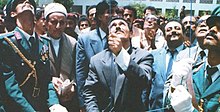
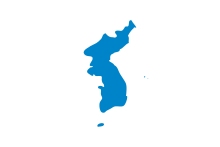
Germany was not the only country that had been divided into two states (1949–1990) due to the
Korea and Vietnam suffered severely from this division in the Korean War (1950–1953) and Vietnam War (1955–1975) respectively, which caused heavy economic and civilian damage.[citation needed] However, German separation did not result in another war.
Moreover, Germany is the only one of these countries that has managed to achieve a peaceful reunification without subsequent violent conflict. For instance, Vietnam achieved reunification after the war under the communist government of
See also
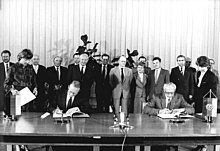
- Inner German relations
- Inner German border
- Dissolution of the Soviet Union
- Chinese unification
- Irish reunification
- Korean reunification
- Transitology
- Vietnamese reunification
- Yemeni unification
Notes
- ^ Germany was divided into East and West Germany in 1949 but the map shows 2 Germanies when the Saarland joined West Germany in 1957.
- ^ The sentence "Germany as a whole" was recorded in the Potsdam Agreement to mention Germany.
- IOC and Germany was represented by a single teamin the Winter and Summer Olympics until 1968.
- ^ Kristina Spohr reports that German historian Werner Weidenfeld says that Bush fully trusted Kohl and made the United States his most important ally in the unification process.[71]
- ^ The territory of the League of Nations mandate of the Free City of Danzig, annexed by Poland in 1945 and comprising the city of Gdańsk (Danzig) and a number of neighboring cities and municipalities, had never been claimed by any official side because West Germany followed the legal position of Germany in its borders of 1937, thus before the 13 March 1938 Nazi annexation of Austria.
- ^ In fact, a new constitution was drafted by a "round table" of dissidents and delegates from East German civil society only to be discarded later, a fact that upset many East German intellectuals.[98]
- ^ For example, the economist Jörg Roesler.[103] The historian Ulrich Busch pointed out that the currency union as such had come too early.[104]
References
- ^ a b c "EinigVtr – Vertrag zwischen der Bundesrepublik Deutschland und der Deutschen Demokratischen Republik über die Herstellung der Einheit Deutschlands". www.gesetze-im-internet.de (in German). Archived from the original on 20 November 2022. Retrieved 6 March 2022.
- ^ ISBN 978-3-205-79496-7, retrieved 6 March 2022
- ^ ISSN 2199-9201.
- ^ "DRA: Archivnachweise". 9 June 2009. Archived from the original on 18 July 2011. Retrieved 5 November 2009.
- ^ Pfeil, Ulrich (9 April 2020). "Die DDR als Zankapfel in Forschung und Politik". bpb.de (in German). Archived from the original on 18 July 2023. Retrieved 14 December 2022.
- ^ Mühlbauer, Peter (29 January 2015). "War die deutsche Wiedervereinigung eine Annexion?". Telepolis (in German). Archived from the original on 14 December 2022. Retrieved 14 December 2022.
- from the original on 13 February 2024. Retrieved 6 June 2023.
- ^ "Unification or annexation? – DW – 09/01/2010". dw.com. Archived from the original on 18 July 2023. Retrieved 18 November 2022.
- ^ "Germany's reunification plunge". BBC News. 30 September 2010. Archived from the original on 18 July 2023. Retrieved 18 November 2022.
- from the original on 23 August 2019. Retrieved 18 November 2022.
- ^ "Duma May Slam East German 'Annexation'". Radio Free Europe/Radio Liberty. 29 January 2015. Archived from the original on 18 July 2023. Retrieved 18 November 2022.
- ^ "Ned Richardson-Little on Twitter". Twitter. Archived from the original on 13 December 2022. Retrieved 13 December 2022.
- ISSN 0190-8286. Retrieved 18 November 2022.
- ^ "Beitritt zur BRD: Vom Westen "überrannt"? | MDR.DE". Mitteldeutscher Rundfunk (in German). Archived from the original on 29 March 2023. Retrieved 13 December 2022.
- ^ "12 Germans who got played by Putin". POLITICO. 5 May 2022. Archived from the original on 29 May 2022. Retrieved 6 June 2023.
- ^ Heller, Kevin Jon (2011). The Nuremberg Military Tribunals. OUP. p. 116.
- ^ Ziemke, Earl Frederick (1990). The US Army and the Occupation of Germany 1944–1946. Center of Military History, United States Army. p. 114.
- ^ Tonia Koch: Die Präambel macht den Unterschied. Zur Landesverfassung des Saarlands und ihrer Geschichte. Archived 29 March 2017 at the Wayback Machine In: Deutschlandfunk, 23 January 2013; Aufbau der Demokratie an der Saar. Archived 16 May 2023 at the Wayback Machine In: Landtag-Saar.de.
- ^ "The division of Germany". Centre Virtuel de la Connaissance sur l'Europe. The University of Luxembourg. Archived from the original on 31 July 2019. Retrieved 31 July 2019.
- ^ J. Robert Wegs & Robert Ladrech (1996). Europe since 1945: a concise history. New York.
- ISBN 3-406-06035-8, p. 18.
- ^ Government of the German Democratic Republic (1 October 1959). "Gesetz zur Änderung des Gesetzes über das Staatswappen und die Staatsflagge der Deutschen Demokratischen Republik". documentArchiv.de (in German). Archived from the original on 13 November 2019. Retrieved 24 February 2008.
- ISBN 978-0313281129.
- ISBN 978-1-61530-991-7.
- ISBN 978-0-8160-7471-6.
- ^ "Basic Treaty | 1972 | Britannica". Archived from the original on 16 May 2023. Retrieved 16 May 2023.
- from the original on 6 March 2022. Retrieved 6 March 2022.
- from the original on 13 February 2024. Retrieved 6 March 2022.
- from the original on 12 June 2018. Retrieved 6 March 2022.
- ISBN 978-1-315-75694-3, archivedfrom the original on 12 April 2021, retrieved 6 March 2022
- ISBN 978-3657779352, archivedfrom the original on 6 March 2022, retrieved 6 March 2022
- from the original on 13 February 2024. Retrieved 6 March 2022.
- from the original on 1 September 2020. Retrieved 6 March 2022.
- ^ "Helmut Kohl's Ten-Point Plan for German Unity (November 28, 1989)". germanhistorydocs.ghi-dc.org. Archived from the original on 20 November 2022. Retrieved 5 March 2022.
- ^ "Vertrag über die Schaffung einer Währungs-, Wirtschafts- und Sozialunion zwischen der Deutschen Demokratischen Republik und der Bundesrepublik Deutschland". Die Verfassungen in Deutschland. Archived from the original on 29 October 2013. Retrieved 22 March 2013.
- ^ "German Unification Monetary union". Cepr.org. 1 July 1990. Archived from the original on 25 July 2011. Retrieved 19 October 2010.
- ^ a b c "Embassy of the Federal Republic of Germany London – A short history of German reunification". London.diplo.de (in German). Archived from the original on 7 June 2010. Retrieved 19 October 2010.
- ^ "Leben in der DDR". www.mdr.de (in German). Archived from the original on 13 February 2024. Retrieved 6 March 2022.
- ^ "Volkskammer der DDR stimmt für Beitritt". Bundeszentrale für politische Bildung (in German). BPD.de. Archived from the original on 2 December 2013. Retrieved 6 March 2022.
- ^ a b c "Bundesarchiv – Digitalisierung und Onlinestellung des Bestandes DA 1 Volkskammer der DDR, Teil 10. Wahlperiode". www.bundesarchiv.de (in German). Archived from the original on 20 October 2015. Retrieved 6 March 2022.
- NBC Learn. Archived from the original(PDF) on 4 October 2013. Retrieved 22 March 2013.
- Deutschland.de. Archived from the originalon 16 May 2013. Retrieved 22 March 2013.
- AP News Archive. Archivedfrom the original on 7 August 2020. Retrieved 22 March 2013.
- ^ "Opening of the Berlin Wall and Unification: German History". germanculture.com.ua. Archived from the original on 13 August 2022. Retrieved 6 March 2022.
- ^ "Bundesgesetzblatt" (PDF). Bgbl.de. Archived (PDF) from the original on 7 December 2016. Retrieved 9 October 2016.
- ^ "Art 45 EinigVtr – Einzelnorm". www.gesetze-im-internet.de. Archived from the original on 9 March 2023. Retrieved 5 March 2022.
- ^ "Germany Today – The German Unification Treaty". Europe-today.com. Archived from the original on 20 July 2008. Retrieved 19 October 2010.
- ISBN 978-0-8223-9538-6. Archivedfrom the original on 13 February 2024. Retrieved 6 March 2022.
- ISBN 978-0-8014-4909-3, archivedfrom the original on 13 February 2024, retrieved 19 October 2010
- ^ ISBN 978-9264101463. Archivedfrom the original on 13 February 2024. Retrieved 6 March 2022.
- ^ ]
- ^ ISBN 978-0-333-79368-8.
- ^ .
- ^ .
- ISBN 1136250646
- ^ "Deutsche Welle (dw.de) (9.11.2004). Schicksalstag der Deutschen". Archived from the original on 5 May 2015. Retrieved 17 May 2023.
- ^ JSTOR 20027216.
- ^ from the original on 6 March 2023. Retrieved 6 March 2023.
- ^ from the original on 6 March 2023. Retrieved 6 March 2023.
- ^ from the original on 6 March 2023. Retrieved 6 March 2023.
- from the original on 6 March 2023. Retrieved 6 March 2023.
Throughout the fall, two-thirds of all respondents welcomed the GDR refugees; in December 1989, however, barely one-quarter expressed full understanding for people still emigrating, and the support quickly dwindled to just 11 percent by April 1990.
- ^ from the original on 6 March 2023. Retrieved 6 March 2023.
- ^ from the original on 6 March 2023. Retrieved 6 March 2023.
- from the original on 25 June 2023. Retrieved 24 June 2023.
- ^ Hans-Hermann Hoppe (1 February 2012). "The Politics of Johann Wolfgang Goethe". Mises Institute. Archived from the original on 6 June 2022. Retrieved 17 May 2019.
- ^ a b c d e f g h i j k l Wiegrefe, Klaus (29 September 2010). "An Inside Look at the Reunification Negotiations". Der Spiegel. Archived from the original on 7 January 2019. Retrieved 4 October 2010.
- ^ "Russia and German reunification: Opposing views on Mikhail Gorbachev's legacy". www.dw.com. Deutsche Welle. 2 October 2020. Archived from the original on 16 March 2023. Retrieved 6 March 2022.
- ^ Skelton, George (26 January 1990). "The Times Poll : One Germany: U.S. Unfazed, Europeans Fret". Los Angeles Times. Archived from the original on 7 April 2022. Retrieved 16 June 2012.
- from the original on 28 May 2022. Retrieved 6 March 2022.
- from the original on 13 February 2024. Retrieved 6 March 2022.
- from the original on 6 March 2022. Retrieved 6 March 2022.
- ^ a b c d e Volkery, Carsten (9 November 2009). "The Iron Lady's Views on German Reunification/'The Germans Are Back!'". Der Spiegel. Archived from the original on 18 May 2012. Retrieved 5 October 2010.
- ^ a b Michael Binyon (11 September 2009). "Thatcher told Gorbachev Britain did not want German reunification". The Times. London. Archived from the original on 16 July 2011. Retrieved 8 November 2009.
- ^ a b c d e f g Kundnani, Hans (28 October 2009). "Margaret Thatcher's German war". The Times. Archived from the original on 27 May 2022. Retrieved 5 October 2010.
- ^ a b Anne-Laure, Mondesert (AFP) (31 October 2009). "London and Paris were shocked by German reunification". Calgary Herald. Archived from the original on 4 November 2009. Retrieved 9 November 2009.
- ^ Peter Allen (2 November 2009). "Margaret Thatcher was 'horrified' by the prospect of a reunited Germany". The Daily Telegraph. London. Archived from the original on 11 January 2022. Retrieved 9 November 2009.
- ^ Knight, Ben (8 November 2009). "Germany's neighbors try to redeem their 1989 negativity". Deutsche Welle. Archived from the original on 11 November 2009. Retrieved 9 November 2009.
- ^ a b Folli, Stefano (7 May 2013). "The Incarnation of Politics Is Gone". Il Sole 24 Ore. Archived from the original on 26 October 2014. Retrieved 21 October 2014.
- ^ "Special Meeting of the European Council – Presidency Conclusions". European Commission. Dublin. 28 April 1990. Archived from the original on 25 August 2020. Retrieved 5 March 2022.
- ^ "Special meeting of the European Council" (PDF). Dublin: The European Council. 28 April 1990. Archived (PDF) from the original on 2 April 2012. Retrieved 5 March 2022.
- ^ Scally, Derek (29 April 2010). "Germany will 'never forget' Ireland's help". The Irish Times. Archived from the original on 11 November 2020. Retrieved 5 March 2022.
- ^ "Find a Debate – Houses of the Oireachtas". www.oireachtas.ie. Houses of the Oireachtas. 3 March 2022. Archived from the original on 17 February 2009. Retrieved 5 March 2022.
- ^ Kohl, Helmut (29 November 1989). "Helmut Kohl's Ten-Point Plan for German Unity". Translated by Jeremiah Riemer. German History in Documents and Images. Archived from the original on 1 August 2020. Retrieved 16 June 2012.
- ^ "I Preferred To See It as an Acquisition". Der Spiegel. 29 September 2010. Archived from the original on 3 October 2010. Retrieved 7 October 2010.
- ^ "Treaty on the Final Settlement with respect to Germany" (PDF). 12 September 1990. Archived from the original (PDF) on 9 July 2017. Retrieved 16 December 2018.
- ^ "Soviets may return Honecker to West". Los Angeles Times. 26 August 1991. Archived from the original on 20 February 2015. Retrieved 13 December 2022.
- ^ a b "Resources for The 1990 reunification – Historical events in the European integration process (1945–2014)". Cvce.eu. CVCE. Archived from the original on 21 October 2016. Retrieved 9 October 2016.
- ^ Kinzer, Stephen (9 September 1994). "Allies' Departure Leaves Berlin Without Foreign Troops". NYTimes.com. Berlin, Germany. Archived from the original on 11 March 2023. Retrieved 5 April 2017.
- ^ Pifer, Steven (30 November 2001). "Did NATO Promise Not to Enlarge? Gorbachev Says "No"". Brookings. Archived from the original on 1 November 2019. Retrieved 5 March 2022.
- ^ "Breaking Down the Wall in the Head". Deutsche Welle. 3 October 2004. Archived from the original on 23 February 2011. Retrieved 11 October 2009.
- ^ Cameron, Abadi (7 August 2009). "The Berlin fall". Foreign Policy. Archived from the original on 9 August 2009. Retrieved 11 October 2009.
- S2CID 218888433.
- from the original on 13 February 2024. Retrieved 6 March 2022.
- ^ "Underestimating East Germany". The Atlantic. 6 November 2009. Archived from the original on 11 March 2023. Retrieved 25 October 2013.
- ^ Joffe, Josef (8 November 2009). "After the fall 20 years ago this week, the crumbling of the Berlin Wall began an empire's end". Anniston Star. Archived from the original on 7 July 2011. Retrieved 19 October 2010.
- ISBN 978-0-275-96177-0. Archivedfrom the original on 13 February 2024. Retrieved 18 May 2022.
- ^ Solms-Laubach, Franz (20 May 2009). "Umfrage: Ost- und Westdeutsche entfernen sich voneinander". Die Welt (in German). Archived from the original on 11 March 2023. Retrieved 19 October 2010.
- S2CID 184882749.
- ^ "Gastbeitrag: Nicht für die Ewigkeit – Staat und Recht – Politik". Faz.net (in German). Archived from the original on 3 October 2010. Retrieved 19 October 2010.
- ^ "Horst Dreier | Das Grundgesetz – eine Verfassung auf Abruf?". Das-parlament.de (in German). 27 April 2009. Archived from the original on 18 July 2011. Retrieved 19 October 2010.
- ^ DDR-Geschichte: Merkel will Birthler-Behörde noch lange erhalten Archived 9 June 2009 at the Wayback Machine. Spiegel.de (15 January 2009). Retrieved 19 October 2010.
- ^ "Facts about Germany: Society". Tatsachen-ueber-deutschland.de. Archived from the original on 16 February 2010. Retrieved 19 October 2010.
- S2CID 184882749.
- S2CID 184882749.
- from the original on 14 March 2023. Retrieved 5 March 2022.
- ISBN 0-415-14124-9. Archivedfrom the original on 13 February 2024. Retrieved 17 October 2020.
- from the original on 13 February 2024. Retrieved 6 March 2022.
- .
- S2CID 144040097.
- ^ from the original on 13 February 2024. Retrieved 6 March 2022.
- ^ .
- ^ ISBN 978-3-8376-2448-9
- ISBN 978-9264101463. Archivedfrom the original on 13 February 2024. Retrieved 6 March 2022.
- S2CID 183674585
- ^ "Germany's wealth distribution most unequal in euro zone: study". Reuters. 26 February 2014. Archived from the original on 23 September 2015. Retrieved 23 September 2015.
- S2CID 153436467.
- ^ from the original on 8 March 2022. Retrieved 6 March 2022.
- from the original on 13 February 2024. Retrieved 6 March 2022.
- from the original on 13 February 2024. Retrieved 6 March 2022.
- ^ SPIEGEL, DER (12 September 2011). "Interview with Former German Finance Minister : 'Germans Will Have to Pay'". Der Spiegel. Archived from the original on 6 March 2023. Retrieved 25 June 2021.
- ^ Wike, Richard; Poushter, Jacob; Silver, Laura; Devlin, Kat; Fetterolf, Janell; Castillo, Alexandra; Huang, Christine (9 October 2019). "Germans view unification positively but feel the East has been left behind". Pew Research Center | Global Attitudes and Trends. Pew Research Center. Archived from the original on 6 March 2023. Retrieved 21 July 2020.
- ^ Wike, Richard; Poushter, Jacob; Silver, Laura; Devlin, Kat; Fetterolf, Janell; Castillo, Alexandra; Huang, Christine (9 October 2019). "Most in former Eastern Bloc approve of shift to multiparty and free market systems". Pew Research Center | Global Attitudes and Trends. Pew Research Center. Archived from the original on 6 March 2023. Retrieved 21 July 2020.
- ^ Wike, Richard; Poushter, Jacob; Silver, Laura; Devlin, Kat; Fetterolf, Janell; Alex; Castillo, ra; Huang, Christine (15 October 2019). "European Public Opinion Three Decades After the Fall of Communism". Pew Research Center's Global Attitudes Project. Archived from the original on 6 March 2023. Retrieved 5 March 2022.
- ^ Chambers, Madeline (25 September 2019). "30 years after fall of Berlin Wall, East Germans feel inferior". Reuters.
- ^ "Former East Germany still lags behind west". Deutsche Welle. 25 September 2019. Archived from the original on 29 January 2024. Retrieved 29 January 2024.
- ^ from the original on 7 December 2021. Retrieved 7 December 2021.
- ^ Joebges, Heike; Zwiener, Rudolf; Albu, Nora (2022). "The long-term effects of German unification on wages, employment and growth: a trigger for a shift to a new market constellation". European Journal of Economics and Economic Policies: Intervention. 19 (2). Edward Elgar Publishing Ltd.: 278–293.
- ^ Bennett, Bruce W. (19 September 2013). "Preparing for the Possibility of a North Korean Collapse". Rand. Archived from the original on 30 November 2022. Retrieved 6 March 2022.
- ^ "The European dimension of German-Taiwanese relations – a critical assessment" (PDF). Archived (PDF) from the original on 26 April 2018.
Further reading
- Blumenau, Bernhard, 'German Foreign Policy and the ‘German Problem’ During and After the Cold War: Changes and Continuities'. in: B Blumenau, J Hanhimäki & B Zanchetta (eds), New Perspectives on the End of the Cold War: Unexpected Transformations? Ch. 5. London: Routledge, 2018. ISBN 978-1138731349.
- Engel, Jeffrey A. When the World Seemed New: George H. W. Bush and the End of the Cold War (2018) pp. 273–291.
- Maier, Charles S., Dissolution: The Crisis of Communism and the End of East Germany (Princeton UP, 1997).
- Meacham, Jon. Destiny and Power: The American Odyssey of George Herbert Walker Bush (2015), pp. 397–408.
- Schemper, Lukas. "Diasporas and American debates on German unification." Journal of Transatlantic Studies 15.1 (2017): 41–60 online[dead link].
- Spohr, Kristina. "German Unification: Between Official History, Academic Scholarship, and Political Memoirs" Historical Journal 43#3 (2000), pp. 869–888, at p. 876. online.
- Zelikow, Philip and Condoleezza Rice, Germany Unified and Europe Transformed: A Study in Statecraft (Harvard University Press, 1997) excerpt.
- Sites of Unity, Online Project about German reunification of Haus der Geschichte, 2022.
Primary sources
- Jarausch, Konrad H., and Volker Gransow, eds. Uniting Germany: Documents and Debates, 1944–1993 (1994), primary sources in English translation
External links
- The Unification Treaty (Berlin, 31 August 1990) website of CVCE (Centre of European Studies)
- Hessler, Uwe, "The End of East Germany", dw-world.de, 23 August 2005.
- Berg, Stefan, Steffen Winter and Andreas Wassermann, "Germany's Eastern Burden: The Price of a Failed Reunification", Der Spiegel, 5 September 2005.
- Wiegrefe, Klaus, "An Inside Look at the Reunification Negotiations", Der Spiegel, 29 September 2010.
- "Unfriendly, even dangerous"? Margaret Thatcher and German Unification, Academia.edu, 2016.
- Problems with Reunification from the Dean Peter Krogh Foreign Affairs Digital Archives
